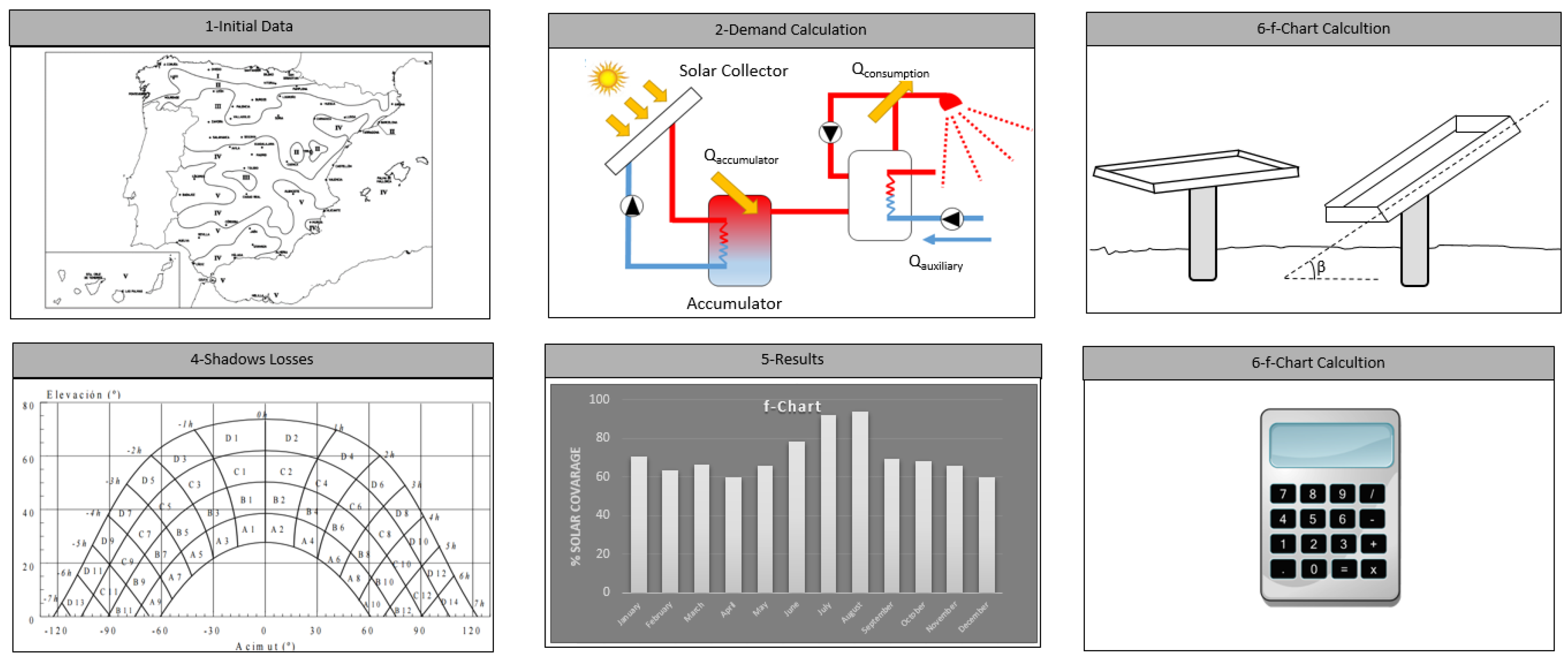Software for Obtaining the Solar Coverage of a Solar Thermal Energy Installation for Domestic Hot Water Supply by Applying the f-Chart Method †
Abstract
1. Introduction
2. Methodology
- Tab: [Home]
- Tab: [1-Initial data]
- Tab: [2-Demand calculation]
- Tab: [3-Surface sizing]
- Tab: [4-Shadow losses]
- Tab: [5-Results]
- Tab: [6-f-Chart calculation]
- Establishment: 5-star hotel;
- Maximum capacity: 50 people;
- Location: Sevilla, Spain;
- Positioning of the collectors: On a gabled roof with an inclination of 45° by superposition;
- Orientation of the collectors: S-SE forming 30° with South.
3. Results
- The installation is located in a climatic zone V, with a latitude of 37.2°;
- The average demand of the installation is 1934.88 L/day;
- The required accumulation volume has a value of 100 L/m2;
- The optimum inclination of the collectors is 47.2°;
- Losses due to orientation and inclination are 3.208% and shadows are 3.280%. In total, the losses are of 6.488%;
- The number of collectors needed is 22. These collectors occupy a total area of 41.8 m2;
- Solar coverage is set at 67.123%;
- The minimum solar coverage established by the CTE is set at 60%.
4. Conclusions
References
- Technical Building Code CBC, 2016. Documento Básico HE—Ahorro de energía, Ministerio de Fomento. Available online: https://www.codigotecnico.org/ (accessed on 1 November 2018).[Green Version]
- UNE 94002:2005. Thermal Solar Systems for Domestic Hot Water Production. Calculation Method for Heat Demand; Asociacion Espanola de Normalizacion: Madrid, Spain, 2005. [Google Scholar][Green Version]
- UNE 94003:2007. Climatic Data for the Dimensioning of Solar Thermal Systems; Asociacion Espanola de Normalizacion: Madrid, Spain, 2007. [Google Scholar][Green Version]
- UNE-EN 12975-1:2006+A1:2011. Thermal Solar Systems and Components—Solar Collectors—Part 1: General Requirements; SAI Global: Sydney, Australia, 2011. [Google Scholar][Green Version]
- UNE-EN 12977-3:2009. Thermal Solar Systems and Components—Custombuilt Systems—Part 3: Performance Test Methods for Solar Water Heater Stores; SAI Global: Sydney, Australia, 2009. [Google Scholar][Green Version]

Publisher’s Note: MDPI stays neutral with regard to jurisdictional claims in published maps and institutional affiliations. |
© 2018 by the authors. Licensee MDPI, Basel, Switzerland. This article is an open access article distributed under the terms and conditions of the Creative Commons Attribution (CC BY) license (https://creativecommons.org/licenses/by/4.0/).
Share and Cite
Álvarez, S.S.; García, M.P.C. Software for Obtaining the Solar Coverage of a Solar Thermal Energy Installation for Domestic Hot Water Supply by Applying the f-Chart Method. Proceedings 2018, 2, 1449. https://doi.org/10.3390/proceedings2231449
Álvarez SS, García MPC. Software for Obtaining the Solar Coverage of a Solar Thermal Energy Installation for Domestic Hot Water Supply by Applying the f-Chart Method. Proceedings. 2018; 2(23):1449. https://doi.org/10.3390/proceedings2231449
Chicago/Turabian StyleÁlvarez, Sofía Sánchez, and Mª Pilar Castro García. 2018. "Software for Obtaining the Solar Coverage of a Solar Thermal Energy Installation for Domestic Hot Water Supply by Applying the f-Chart Method" Proceedings 2, no. 23: 1449. https://doi.org/10.3390/proceedings2231449
APA StyleÁlvarez, S. S., & García, M. P. C. (2018). Software for Obtaining the Solar Coverage of a Solar Thermal Energy Installation for Domestic Hot Water Supply by Applying the f-Chart Method. Proceedings, 2(23), 1449. https://doi.org/10.3390/proceedings2231449




